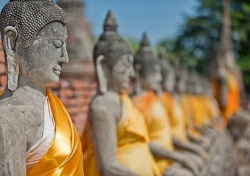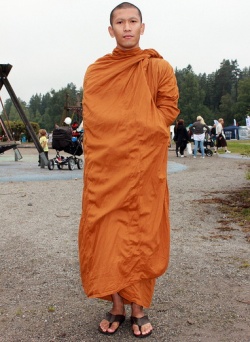Buddhism scholarship and research
by Wendy Dossett
Scholarship and Research
There are two general problems for the teacher researching scholarship on Buddhism. These are:
a) the focus on the Theravada tradition in scholarship, and
b) the focus on a text-based approach. There is a bias towards Theravada Buddhism in many presentations of Buddhism at every level of education because Theravada was the first form of Buddhism to be encountered and written about.
Early British pioneers, such as TW Rhys David, Ananda Metteya and others encountered Theravada Buddhism as a result of British colonial links with Asian countries in which Theravada dominated. This accident of history, coupled with the Western notion that historically earlier forms of the religion are somehow more ‘authentic’ than historically later ‘explications’, lead to an inappropriately strong emphasis on Theravada as the normative version of Buddhism. This has numerous consequences for the study of Buddhism, because the predominant popular (media-produced) image of Buddhism is that of the Theravada monk. The vast majority of Buddhists worldwide are not monks or nuns.
The impression that monastic Buddhism is ‘proper’ Buddhism leads to value judgements implicit in accounts of the religion. It also leads to the view that the texts and practices appropriate to a monastic context are widely used in Buddhism and constitute the corpus of the Buddhist ‘creed’. This leads to problems when it is discovered that this is far from the case.
Much published research and scholarship in Buddhism focuses understandably on the huge textual corpus of Buddhism. The great effort of the Pali Text Society to make the Pali Canon available in English, undertaken by TW Rhys Davids and IB Horner, dominated English language scholarship in the early period of Buddhist Studies. Later projects have explored Buddhism from the perspectives of a range of disciplines, such as anthropology, ethnography, archaeology, philosophy, sociology, psychology, political science, literary theory, history, and cultural studies.
A robust academic engagement with Buddhism (as with any religion) must necessarily be multi- and inter-disciplinary. Textual studies themselves have now developed far beyond the original focus on the Pali Canon, through the Sanskrit and Tibetan, as well as Chinese, Japanese and other Asian canons.
When exploring the vast array of scholarship on Buddhism, teachers would benefit from bearing in mind the following considerations:
That Buddhism is diverse and there is no group which can be said to be ‘core’ or ‘essential’ Buddhism
That an understanding of the religious language of myth and allegory is helpful for understanding the meaning of the life of the Buddha and of other enlightened beings
That too much focus on the historical Buddha leads to a distorted picture of Buddhism as a whole. There is a tendency in modern religious studies to see religions as equivalent to each other, and therefore ‘founders’ as equivalent. The Buddha does not play the same role in Buddhism as Jesus does in Christianity, or Moses in Judaism.
That Buddhism’s main doctrines are communicable, and the resources of the tradition itself can be used to achieve this (teachers often feel that Buddhism is ‘difficult’ or ‘abstract’ or ‘conceptual’).
That teaching about meditation needs to be set in the doctrinal context of Buddhism
That Buddhism should not be considered the exception to ‘the rule’ that religions are about belief in God (rather ‘the rule’ should be dropped)
That beliefs and practices are diverse and cannot be understood in isolation from their social, cultural and political contexts

